Use of Differential Entropy for Automated Emotion Recognition in a Virtual Reality Environment with EEG Signals
Abstract
1. Introduction
- To the best of our knowledge, we obtained the highest classification accuracy using the VREED dataset;
- This is the first-time Differential Entropy has been used for the VREED dataset.
2. Proposed Method
2.1. Wavelet Transform
2.2. Differential Entropy (DE)
2.3. Dataset
3. Experimental Results
4. Discussion
- (1-)
- The DE feature extraction is a simple method with low computational complexity;
- (2-)
- The DE features are nonlinear in nature, hence able to extract hidden complexities in the EEG signals effectively;
- (3-)
- The RP and PLV methods used in [38] try to capture regular repeating patterns, while DE provides better results for irregular rhythms such as EEG signals. Moreover, DE is a measure of disorder, and our method obtained high classification performance.
- (4-)
- As mentioned in [46], DE features are unsuitable for CNN-type classifiers.
5. Conclusions
Author Contributions
Funding
Institutional Review Board Statement
Informed Consent Statement
Data Availability Statement
Conflicts of Interest
References
- Chalmers, D. The hard problem of consciousness. In The Blackwell Companion to Consciousness; Velmans, M., Schneider, S., Eds.; Blackwell: Malden, MA, USA, 2007; pp. 225–235. [Google Scholar]
- Klinger, E. Thought flow: Properties and mechanisms underlying shifts in content. In At Play in the Fields of Consciousness: Essays in Honor of Jerome L. Singer; Singer, J.A., Salovey, P., Eds.; Erlbaum: Mahwah, NJ, USA, 1999; pp. 29–50. [Google Scholar]
- Robinson, M.D.; Watkins, E.; Harmon-Jones, E. Handbook of Cognition and Emotion; The Guilford Press: New York, NY, USA, 2013; pp. 3–16. [Google Scholar]
- Mohammadi, Z.; Frounchi, J.; Amiri, M. Wavelet-based emotion recognition system using EEG signal. Neural Comput. Appl. 2017, 28, 1985–1990. [Google Scholar] [CrossRef]
- Dalgleish, T.; Power, M. Handbook of Cognition and Emotion; Wiley: New York, NY, USA, 2000. [Google Scholar]
- Russell, J.A. A circumplex model of affect. J. Pers. Soc. Psychol. 1980, 39, 1161. [Google Scholar] [CrossRef]
- Kerkeni, L.; Serrestou, Y.; Mbarki, M.; Raoof, K.; Mahjoub, M.A.; Cleder, C. Automatic Speech Emotion Recognition Using Machine Learning. In Social Media and Machine Learning; IntechOpen: London, UK, 2019; Available online: https://www.intechopen.com/chapters/65993 (accessed on 1 June 2022).
- Canedo, D.; Neves, A.J.R. Facial Expression Recognition Using Computer Vision: A Systematic Review. Appl. Sci. 2019, 9, 4678. [Google Scholar] [CrossRef]
- Santhoshkumar, R.; Geetha, M.K. Deep Learning Approach for Emotion Recognition from Human Body Movements with Feedforward Deep Convolution Neural Networks. Procedia Comput. Sci. 2019, 152, 158–165. [Google Scholar] [CrossRef]
- Ari, B.; Siddique, K.; Alcin, O.F.; Aslan, M.; Sengur, A.; Mehmood, R.M. Wavelet ELM-AE Based Data Augmentation and Deep Learning for Efficient Emotion Recognition Using EEG Recordings. IEEE Access 2022, 10, 72171–72181. [Google Scholar] [CrossRef]
- Usman, M.; Latif, S.; Qadir, J. Using deep autoencoders for facial expression recognition. In Proceedings of the 2017 13th International Conference on Emerging Technologies (ICET), Islamabad, Pakistan, 27–28 December 2017; pp. 1–6. [Google Scholar] [CrossRef][Green Version]
- Lindquist, K.; Wager, T.; Kober, H.; Bliss-Moreau, E.; Barrett, L. The brain basis of emotion: A meta-analytic review. Behav. Brain Sci. 2012, 35, 121–143. [Google Scholar] [CrossRef]
- Wang, C.; Li, S.; Shi, M.; Zhao, J.; Acharya, U.R.; Xie, N.; Cheong, K.H. Multi-Objective Squirrel Search Algorithm for EEG Feature Selection. SSRN. Available online: https://ssrn.com/abstract=4216415 (accessed on 15 June 2022).
- Chowdary, M.K.; Anitha, J.; Hemanth, D.J. Emotion Recognition from EEG Signals Using Recurrent Neural Networks. Electronics 2022, 11, 2387. [Google Scholar] [CrossRef]
- Rodriguez Aguiñaga, A.; Muñoz Delgado, L.; López-López, V.R.; Calvillo Téllez, A. EEG-Based Emotion Recognition Using Deep Learning and M3GP. Appl. Sci. 2022, 12, 2527. [Google Scholar] [CrossRef]
- Şengür, D.; Siuly, S. Efficient approach for EEG-based emotion recognition. Electron. Lett. 2020, 56, 1361–1364. [Google Scholar] [CrossRef]
- Koelstra, S.; Muehl, C.; Soleymani, M.; Lee, J.-S.; Yazdani, A.; Ebrahimi, T.; Pun, T.; Nijholt, A.; Patras, I. DEAP: A Database for Emotion Analysis using Physiological Signals (PDF). IEEE Trans. Affect. Comput. 2012, 3, 18–31. [Google Scholar] [CrossRef]
- Zheng, W.-L.; Lu, B.-L. Investigating Critical Frequency Bands and Channels for EEG-Based Emotion Recognition with Deep Neural Networks. IEEE Trans. Auton. Ment. Dev. 2015, 7, 162–175. [Google Scholar] [CrossRef]
- Soleymani, M.; Lichtenauer, J.; Pun, T.; Pantic, M. A multimodal database for affect recognition and implicit tagging. IEEE Trans. Affect. Comput. 2012, 3, 42–55. [Google Scholar] [CrossRef]
- Alakus, T.B.; Gonen, M.; Turkoglu, I. Database for an emotion recognition system based on EEG signals and various computer games—GAMEEMO. Biomed. Signal Process. Control 2020, 60, 101951. [Google Scholar] [CrossRef]
- Demir, F.; Sobahi, N.; Siuly, S.; Sengur, A. Exploring Deep Learning Features for Automatic Classification of Human Emotion Using EEG Rhythms. IEEE Sensors J. 2021, 21, 14923–14930. [Google Scholar] [CrossRef]
- Tuncer, T.; Dogan, S.; Baygin, M.; Acharya, U.R. Tetromino pattern based accurate EEG emotion classification model. Artif. Intell. Med. 2022, 123, 102210. [Google Scholar] [CrossRef]
- Ismael, A.M.; Alçin, Ö.F.; Abdalla, K.H.; Şengür, A. Two-stepped majority voting for efficient EEG-based emotion classification. Brain Inform. 2020, 7, 9. [Google Scholar] [CrossRef]
- Joshi, V.M.; Ghongade, R.B. EEG based emotion detection using fourth order spectral moment and deep learning. Biomed. Signal Process. Control 2021, 68, 102755. [Google Scholar] [CrossRef]
- Krishna, A.H.; Sri, A.B.; Priyanka, K.Y.; Taran, S.; Bajaj, V. Emotion classification using EEG signals based on tunable-Q wavelet transform. IET Sci. Meas. Technol. 2019, 13, 375–380. [Google Scholar] [CrossRef]
- Yin, Y.; Zheng, X.; Hu, B.; Zhang, Y.; Cui, X. EEG emotion recognition using fusion model of graph convolutional neural networks and LSTM. Appl. Soft Comput. 2021, 100, 106954. [Google Scholar] [CrossRef]
- Chen, T.; Ju, S.; Ren, F.; Fan, M.; Gu, Y. EEG emotion recognition model based on the LIBSVM classifier. Measurement 2020, 164, 108047. [Google Scholar] [CrossRef]
- Chang, C.; Lin, C. LIBSVM: A Library for Support Vector Machines. ACM Trans. Intell. Syst. Technol. 2011, 2, 27. [Google Scholar] [CrossRef]
- Gao, Q.; Yang, Y.; Kang, Q.; Tian, Z.; Song, Y. EEG-based Emotion Recognition with Feature Fusion Networks. Int. J. Mach. Learn. Cybern. 2022, 13, 421–429. [Google Scholar] [CrossRef]
- Xing, X.; Li, Z.; Xu, T.; Shu, L.; Hu, B.; Xu, X. SAE+LSTM: A New Framework for Emotion Recognition From Multi-Channel EEG. Front. Neurorobotics 2019, 13, 37. [Google Scholar] [CrossRef] [PubMed]
- Marín-Morales, J.; Higuera-Trujillo, J.L.; Greco, A.; Guixeres, J.; Llinares, C.; Scilingo, E.P.; Alcañiz, M.; Valenza, G. Affective computing in virtual reality: Emotion recognition from brain and heartbeat dynamics using wearable sensors. Sci. Rep. 2018, 8, 13657. [Google Scholar] [CrossRef]
- Suhaimi, N.S.; Mountstephens, J.; Teo, J. A Dataset for Emotion Recognition Using Virtual Reality and EEG (DER-VREEG): Emotional State Classification Using Low-Cost Wearable VR-EEG Headsets. Big Data Cogn. Comput. 2022, 6, 16. [Google Scholar] [CrossRef]
- Chen, D.-W.; Miao, R.; Yang, W.-Q.; Liang, Y.; Chen, H.-H.; Huang, L.; Deng, C.-J.; Han, N. A Feature Extraction Method Based on Differential Entropy and Linear Discriminant Analysis for Emotion Recognition. Sensors 2019, 19, 1631. [Google Scholar] [CrossRef]
- Li, D.; Xie, L.; Chai, B.; Wang, Z. A feature-based on potential and differential entropy information for electroencephalogram emotion recognition. Electron. Lett. 2022, 58, 174–177. [Google Scholar] [CrossRef]
- Joshi, V.M.; Ghongade, R.B. Optimal Number of Electrode Selection for EEG Based Emotion Recognition using Linear Formulation of Differential Entropy. Biomed. Pharmacol. J. 2020, 13, 645–653. [Google Scholar] [CrossRef]
- Li, Y.; Wong, C.M.; Zheng, Y.; Wan, F.; Mak, P.U.; Pun, S.H.; Vai, M.I. EEG-based emotion recognition under convolutional neural network with differential entropy feature maps. In Proceedings of the 2019 IEEE International Conference on Computational Intelligence and Virtual Environments for Measurement Systems and Applications (CIVEMSA), Tianjin, China, 14–16 June 2019; pp. 1–5. [Google Scholar]
- Zheng, W.-L.; Zhu, J.-Y.; Lu, B.-L. Identifying Stable Patterns over Time for Emotion Recognition from EEG. IEEE Trans. Affect. Comput. 2017, 10, 417–429. [Google Scholar] [CrossRef]
- Yu, M.; Xiao, S.; Hua, M.; Wang, H.; Chen, X.; Tian, F.; Li, Y. EEG-based emotion recognition in an immersive virtual reality environment: From local activity to brain network features. Biomed. Signal Process. Control 2022, 72, 103349. [Google Scholar] [CrossRef]
- Delorme, A.; Makeig, S. EEGLAB: An open source toolbox for analysis of single-trial EEG dynamics including independent component analysis. J. Neurosci. Methods 2004, 134, 9–21. [Google Scholar] [CrossRef] [PubMed]
- Sorkhabi, M.M. Emotion Detection from EEG signals with Continuous Wavelet Analyzing. Am. J. Comput. Res. Repos. 2014, 2, 66–70. [Google Scholar]
- Ko, K.-E.; Yang, H.-C.; Sim, K.-B. Emotion recognition using EEG signals with relative power values and Bayesian network. Int. J. Control. Autom. Syst. 2009, 7, 865–870. [Google Scholar] [CrossRef]
- Shi, L.-C.; Jiao, Y.-Y.; Lu, B.-L. Differential entropy feature for EEG-based vigilance estimation. In Proceedings of the 2013 35th Annual International Conference of the IEEE Engineering in Medicine and Biology Society (EMBC), Osaka, Japan, 3–7 July 2013; pp. 6627–6630. [Google Scholar]
- Shannon, C.E. A mathematical theory of communication. Bell Syst. Tech. J. 1948, 27, 379–423, 623–656. [Google Scholar] [CrossRef]
- Michalowicz, J.V.; Nichols, J.M.; Bucholtz, F. Handbook of Differential Entropy, 1st ed.; Chapman and Hall/CRC: New York, NY, USA, 2013. [Google Scholar] [CrossRef]
- Jurcak, V.; Tsuzuki, D.; Dan, I. 10/20, 10/10, and 10/5 systems revisited: Their validity as relative head-surface-based positioning systems. Neuroimage 2007, 34, 1600–1611. [Google Scholar] [CrossRef] [PubMed]
- Hwang, S.; Hong, K.; Son, G.; Byun, H. Learning CNN features from DE features for EEG-based emotion recognition. Pattern Anal. Appl. 2020, 23, 1323–1335. [Google Scholar] [CrossRef]
- Yang, K.; Tong, L.; Shu, J.; Zhuang, N.; Yan, B.; Zeng, Y. High Gamma Band EEG Closely Related to Emotion: Evidence From Functional Network. Front. Hum. Neurosci. 2020, 14, 89. [Google Scholar] [CrossRef]
- Yang, Y.; Gao, Q.; Song, Y.; Song, X.; Mao, Z.; Liu, J. Investigating of Deaf Emotion Cognition Pattern By EEG and Facial Expression Combination. IEEE J. Biomed. Health Inform. 2022, 26, 589–599. [Google Scholar] [CrossRef]
- Wang, X.-W.; Nie, D.; Lu, B.-L. Emotional state classification from EEG data using machine learning approach. Neurocomputing 2014, 129, 94–106. [Google Scholar] [CrossRef]
- Zheng, W.-L.; Zhu, J.-Y.; Peng, Y.; Lu, B.-L. EEG-based emotion classification using deep belief networks. In Proceedings of the 2014 IEEE International Conference on Multimedia and Expo (ICME), Chengdu, China, 14–18 July 2014; pp. 1–6. [Google Scholar] [CrossRef]
- Zhang, J.; Chen, M.; Hu, S.; Cao, Y.; Kozma, R. PNN for EEG-based Emotion Recognition. In Proceedings of the 2016 IEEE International Conference on Systems, Man, and Cybernetics (SMC), Budapest, Hungary, 9–12 October 2016; pp. 002319–002323. [Google Scholar] [CrossRef]
- Loh, H.W.; Ooi, C.P.; Seoni, S.; Barua, P.D.; Molinari, F.; Acharya, U.R. Application of Explainable Artificial Intelligence for Healthcare: A Systematic Review of the Last Decade (2011–2022). Comput. Methods Programs Biomed. 2022, 226, 107161. [Google Scholar] [CrossRef]
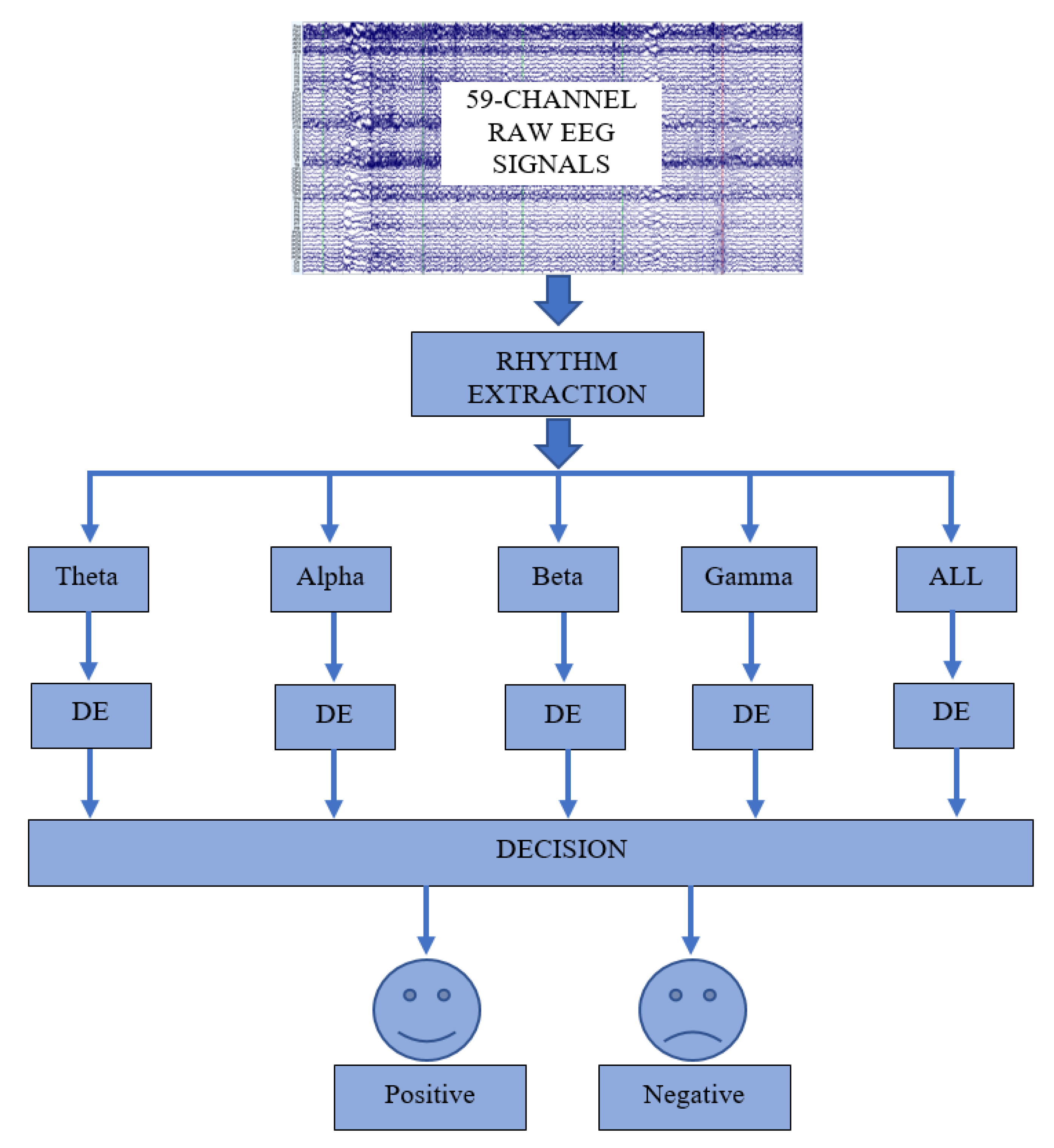
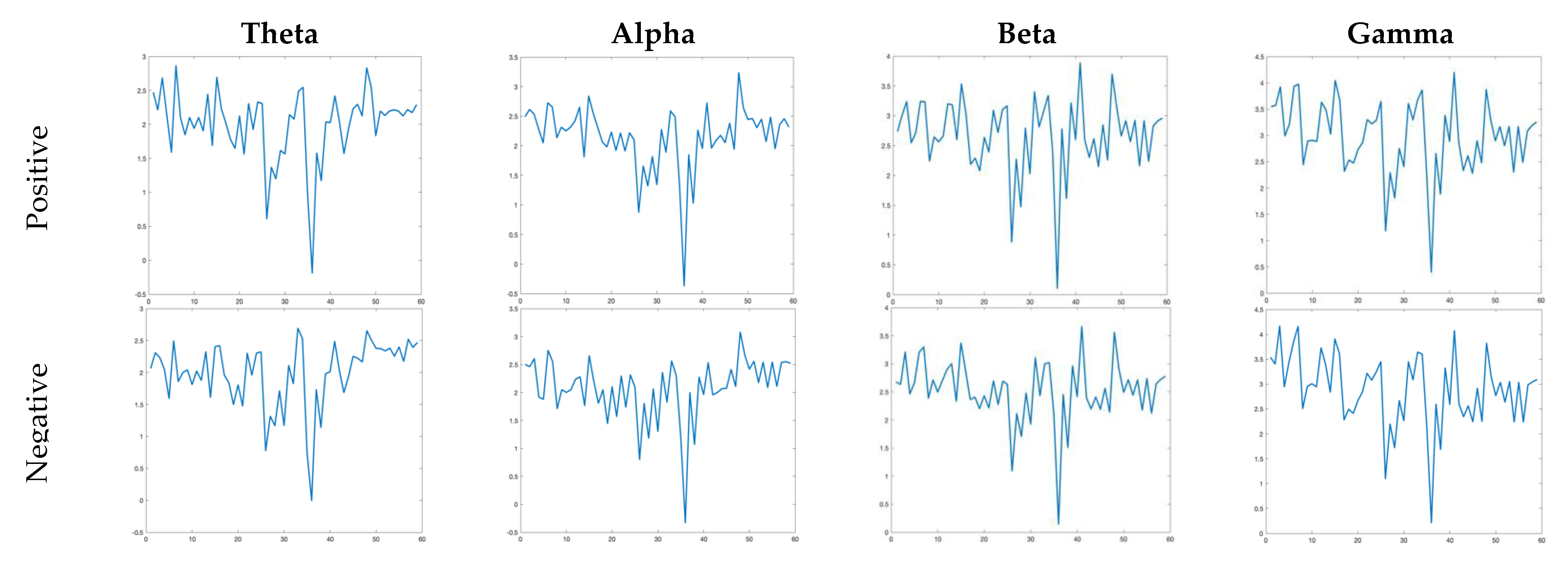
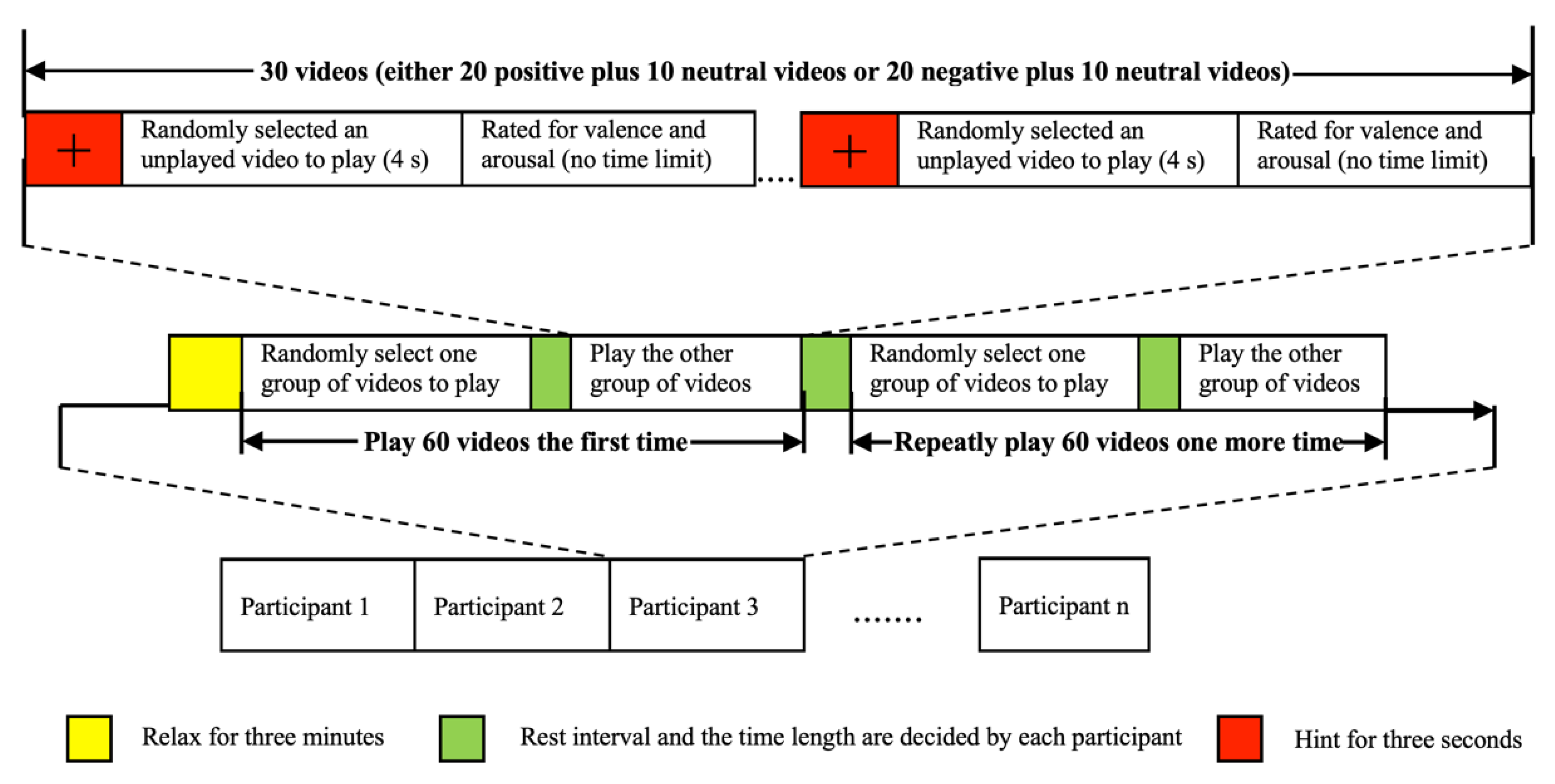
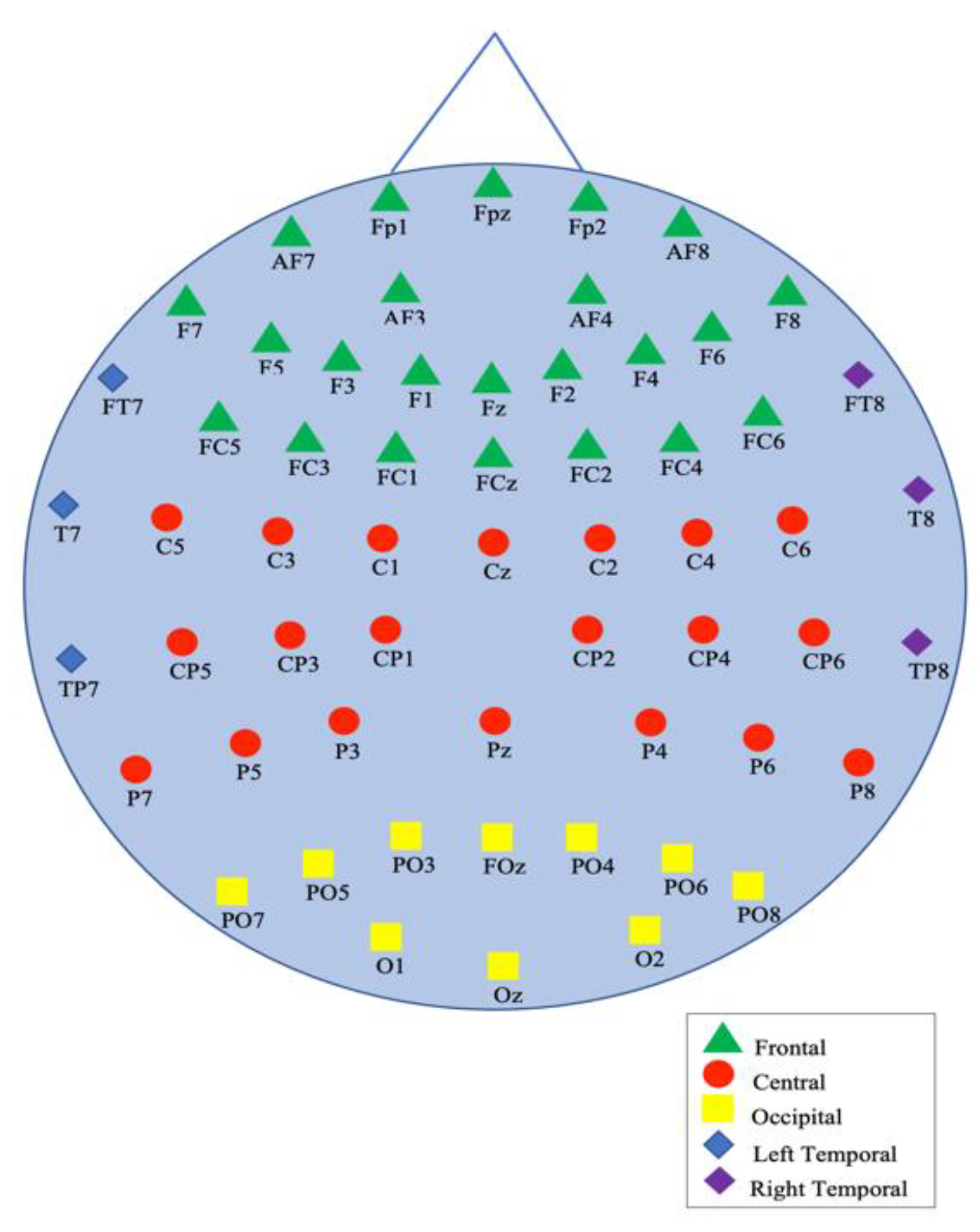
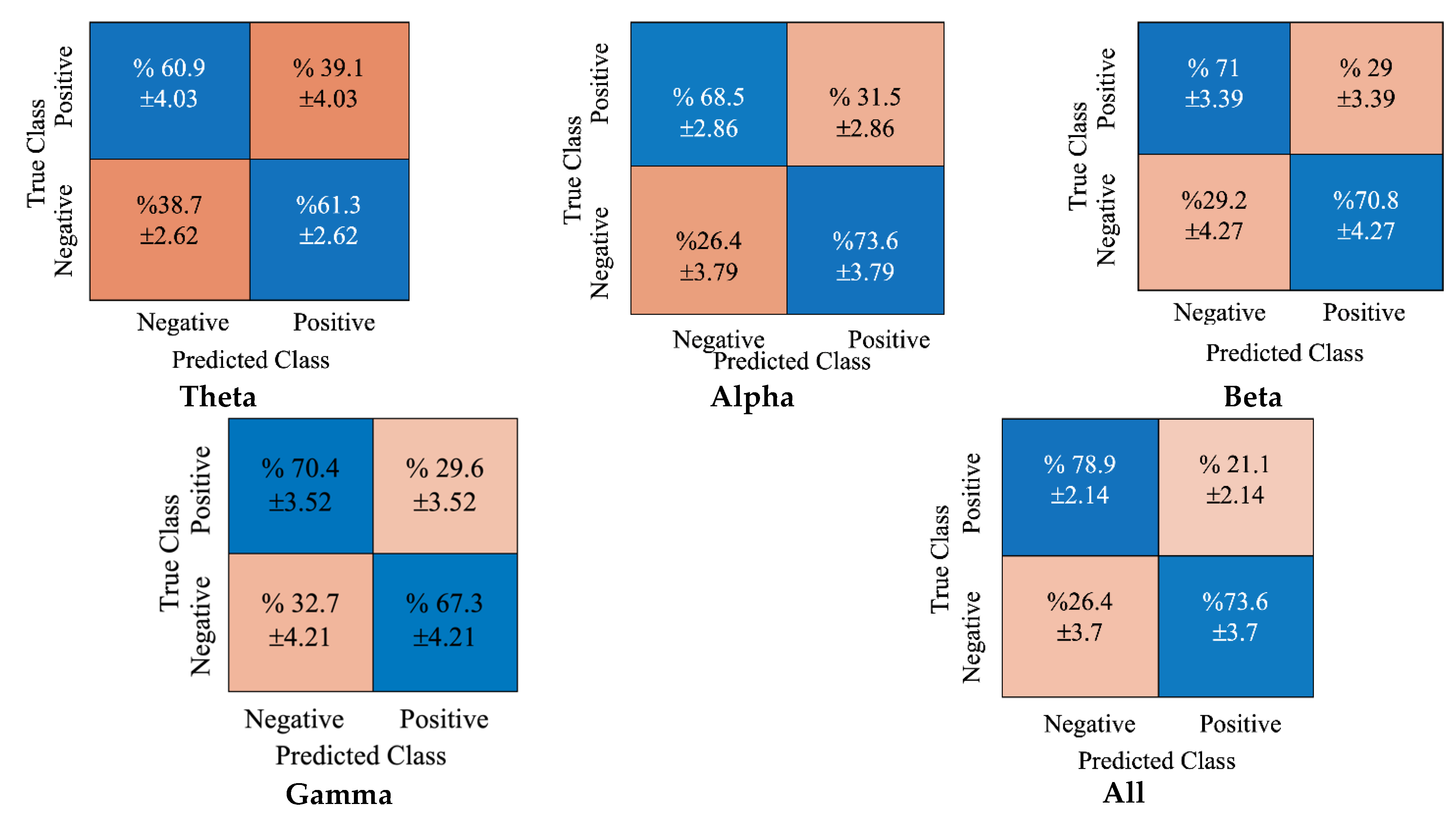
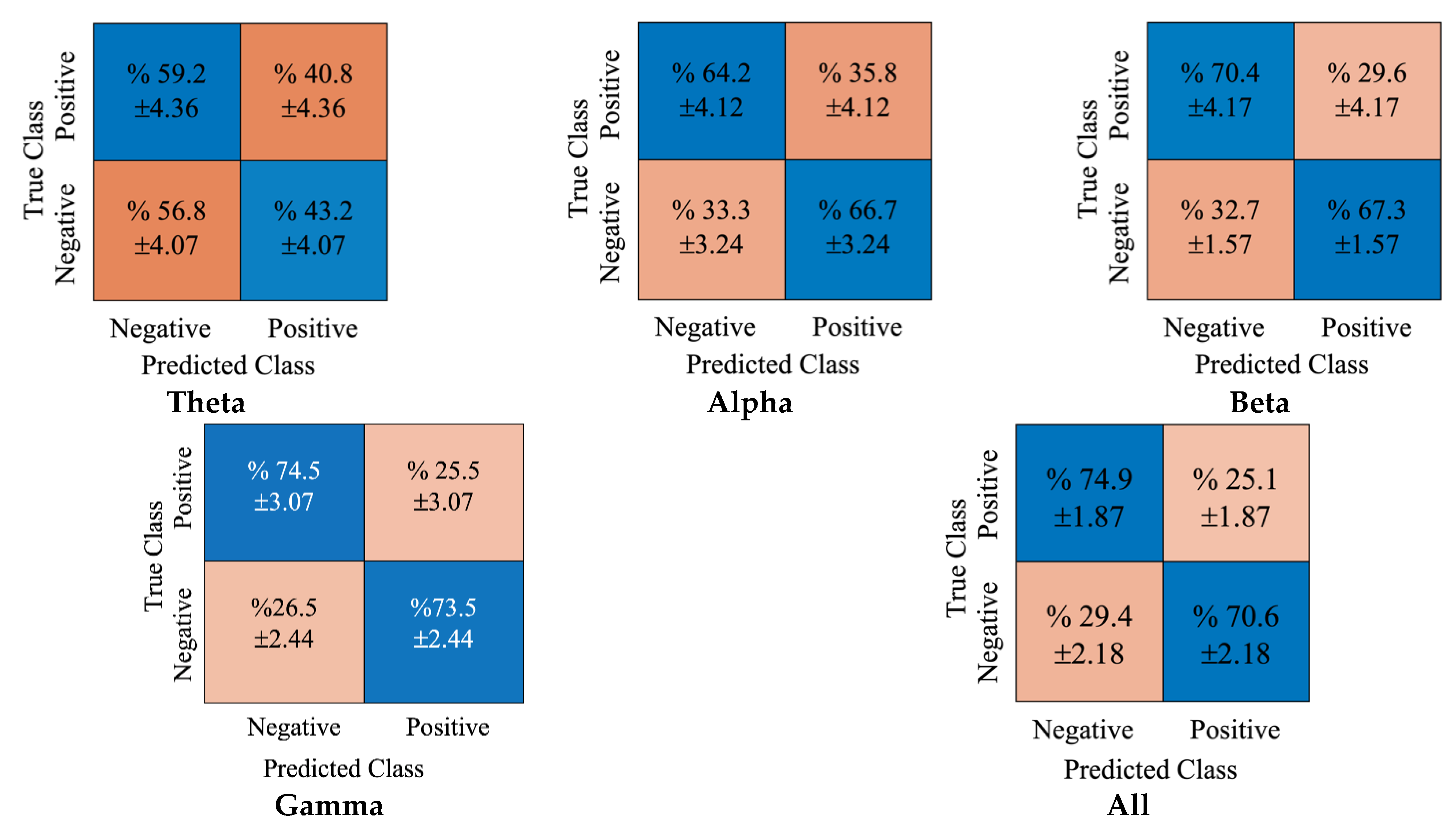

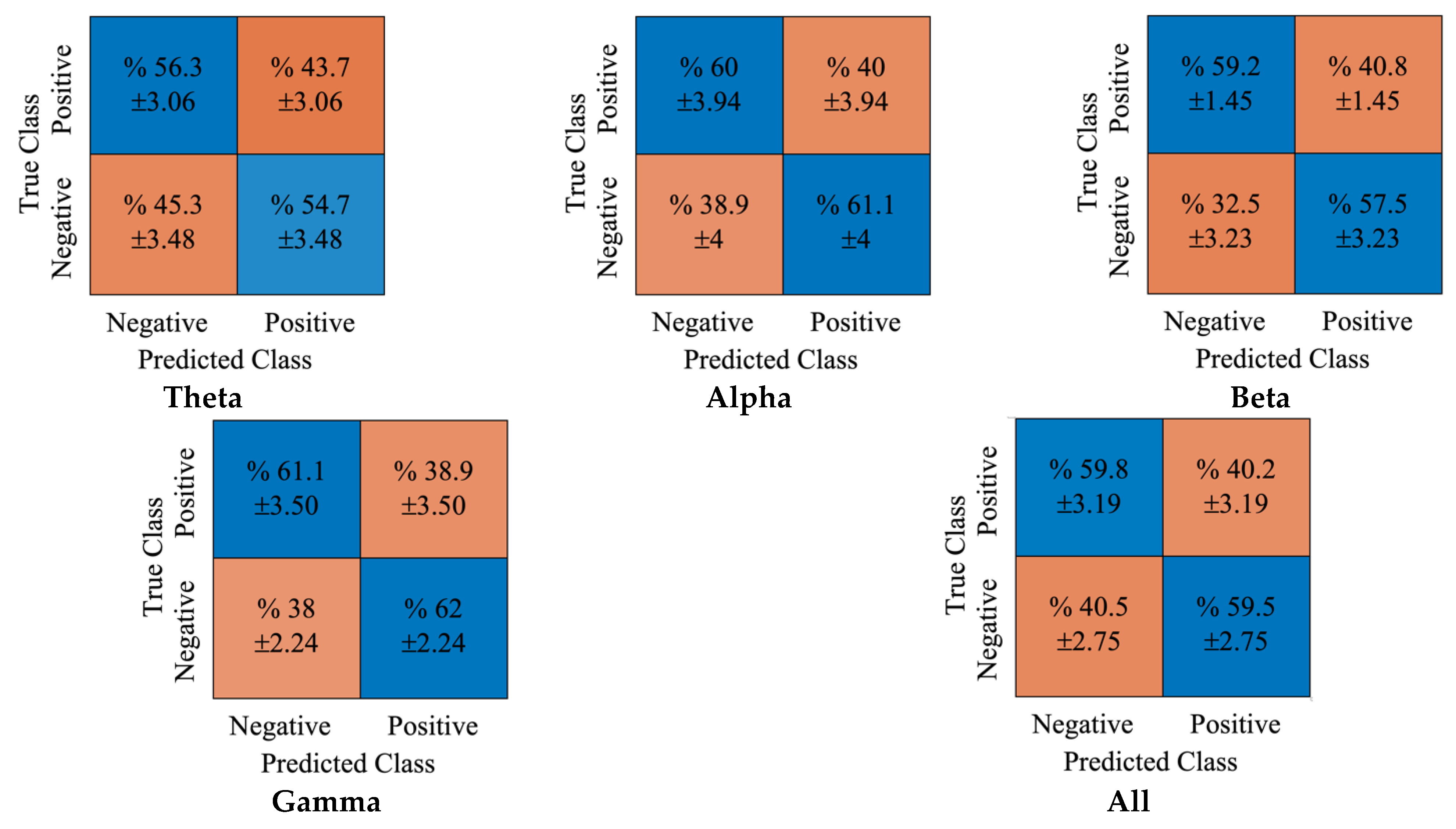
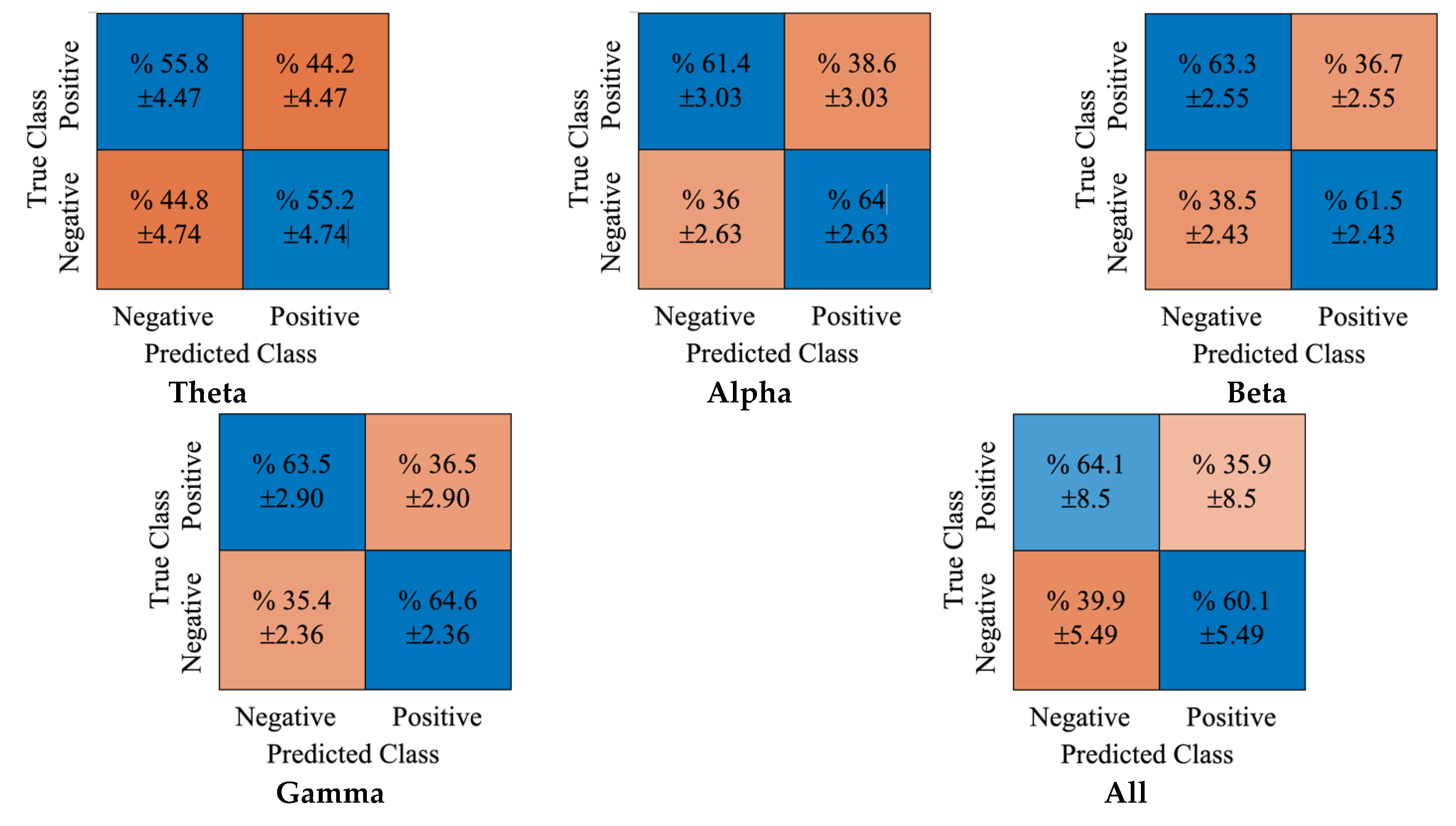
| Frequency Bands | |||||
|---|---|---|---|---|---|
| Used Classifier | Theta | Alpha | Beta | Gamma | ALL |
| SVM | 61.0773 ± 2.1893 | 66.6826 ± 1.4038 | 70.9104 ± 2.6534 | 73.9968 ±1.4518 | 76.2236 ± 2.0648 |
| kNN | 58.0034 ± 3.6462 | 65.4013 ± 1.8120 | 68.8021 ± 2.0587 | 72.9261 ± 1.9973 | 72.6460 ± 1.1198 |
| NB | 54.5211 ± 2.1678 | 57.9541 ± 2.8655 | 54.1148 ± 2.7935 | 59.7951 ± 1.4314 | 59.0151 ± 2.5699 |
| DT | 55.5866 ± 2.6421 | 60.5877 ± 2.1038 | 58.3750 ± 1.4536 | 61.5310 ± 2.8403 | 59.6243 ± 2.0847 |
| LR | 55.5442 ± 2.8434 | 62.6286 ± 2.2601 | 62.4054 ± 1.9679 | 64.0111 ± 1.4145 | 61.6993 ±3.4722 |
| Study | Year | Dataset | Extracted Features | Classifier | Validation Method | Highest Accuracy |
|---|---|---|---|---|---|---|
| Yu et al. [38] | 2022 | VREED | RP | SVM | Hold-out validation (70%–30%) Average of the 10 runs | 73.77% |
| Yu et al. [38] | 2022 | VREED | MPLV | SVM | Hold-out validation (70%–30%) Average of the 10 runs | 67.91% |
| Proposed | 2022 | VREED | DE | SVM | Hold-out validation (70%–30%) Average of the 10 runs | 76.22% |
Publisher’s Note: MDPI stays neutral with regard to jurisdictional claims in published maps and institutional affiliations. |
© 2022 by the authors. Licensee MDPI, Basel, Switzerland. This article is an open access article distributed under the terms and conditions of the Creative Commons Attribution (CC BY) license (https://creativecommons.org/licenses/by/4.0/).
Share and Cite
Uyanık, H.; Ozcelik, S.T.A.; Duranay, Z.B.; Sengur, A.; Acharya, U.R. Use of Differential Entropy for Automated Emotion Recognition in a Virtual Reality Environment with EEG Signals. Diagnostics 2022, 12, 2508. https://doi.org/10.3390/diagnostics12102508
Uyanık H, Ozcelik STA, Duranay ZB, Sengur A, Acharya UR. Use of Differential Entropy for Automated Emotion Recognition in a Virtual Reality Environment with EEG Signals. Diagnostics. 2022; 12(10):2508. https://doi.org/10.3390/diagnostics12102508
Chicago/Turabian StyleUyanık, Hakan, Salih Taha A. Ozcelik, Zeynep Bala Duranay, Abdulkadir Sengur, and U. Rajendra Acharya. 2022. "Use of Differential Entropy for Automated Emotion Recognition in a Virtual Reality Environment with EEG Signals" Diagnostics 12, no. 10: 2508. https://doi.org/10.3390/diagnostics12102508
APA StyleUyanık, H., Ozcelik, S. T. A., Duranay, Z. B., Sengur, A., & Acharya, U. R. (2022). Use of Differential Entropy for Automated Emotion Recognition in a Virtual Reality Environment with EEG Signals. Diagnostics, 12(10), 2508. https://doi.org/10.3390/diagnostics12102508








